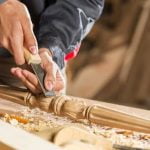The use of sandpaper in woodworking is a common practice in modern times, but did 18th century woodworkers also rely on this abrasive material? The question of whether sandpaper was used during this era has been a subject of debate among historians and woodworking enthusiasts. In this article, we will delve into the significance of sandpaper in woodworking throughout history, specifically focusing on the practices of 18th century woodworkers.
Woodworking in the 18th century was a craft that required precision and skill. From furniture making to cabinetry, woodworkers employed various techniques to shape and smooth their creations. Sandpaper is widely recognized as an essential tool for achieving a smooth surface today, but its role in 18th century woodworking remains unclear.
To understand the context of sandpaper usage during this time period, it is necessary to explore the availability and use of alternative tools and materials. By examining traditional woodworking methods, we can gain insights into how craftsmen achieved smooth surfaces before the widespread use of sandpape.
A Brief Overview of Woodworking Techniques in the 18th Century
Woodworking in the 18th century was a highly skilled craft that required a deep understanding of various techniques and methods. During this time period, woodworkers primarily relied on hand tools to shape and manipulate wood, creating intricate furniture pieces, cabinets, and other wooden objects. This section will provide a brief overview of some of the key woodworking techniques used in the 18th century.
One of the most important woodworking techniques during this time was joinery. Joinery involves joining two or more pieces of wood together without the use of nails or screws. Instead, woodworkers utilized techniques such as dovetail joints, mortise and tenon joints, and tongue and groove joints to create strong and durable connections. These jointing methods required precise measuring, cutting, and shaping of wood to ensure a seamless fit.
Another fundamental technique in 18th-century woodworking was carving. Woodcarving involved using special chisels and gouges to shape decorative elements on furniture or create standalone sculptures. Intricate designs were meticulously carved into the surface of wood using different carving tools with various sizes and shapes.
In addition to joinery and carving, shaping wood through planing was also a common technique in the 18th century. Planing involved using a hand tool called a plane to smooth out rough surfaces or shape wooden boards. The plane would be pushed along the length of the wood, removing thin shavings until the desired shape or smoothness was achieved.
Overall, woodworking in the 18th century required exceptional skill and craftsmanship. Woodworkers employed a variety of techniques such as joinery, carving, and planing to create beautiful and functional wooden objects. While sandpaper may not have been widely used during this time period, these traditional woodworking techniques continue to be celebrated today for their timeless artistry and attention to detail.
| Woodworking Technique | Description |
|---|---|
| Joinery | The process of joining two or more pieces of wood together without nails or screws, utilizing techniques such as dovetail joints, mortise and tenon joints, and tongue and groove joints. |
| Carving | The art of shaping wood by using chisels and gouges to create decorative elements on furniture or standalone sculptures. |
| Planing | The act of shaping wood by using a hand tool called a plane to smooth out rough surfaces or shape wooden boards. |
Historical Context
Availability and Types of Sandpaper
In order to understand the use of sandpaper in 18th century woodworking, it is important to consider the historical context and availability of this material during that time period. During the 18th century, sandpaper was not as readily available as it is today.
The production process for sandpaper involved gluing abrasive materials onto a paper backing, which was a labor-intensive task. As a result, the cost and availability of sandpaper made it a luxury item that was not commonly used by woodworkers.
The types of abrasive materials used in 18th century sandpapers were different compared to those we use today. Instead of modern synthetic abrasives like aluminum oxide or silicon carbide, natural materials such as crushed shells, glass, or minerals were used. These natural abrasives had varying levels of coarseness, depending on their source and processing methods.
Alternatives to Sandpaper
Due to the limited availability and expense of sandpaper during the 18th century, woodworkers often relied on other techniques and materials to smooth and finish their workpieces. One common alternative was using sharp hand tools such as chisels, scrapers, or planes. Skilled craftsmen could achieve impressive results with these tools alone, relying on their expertise in shaping and smoothing wood surfaces.
Another method employed by 18th century woodworkers was burnishing. Burnishing involved rubbing the surface of the wood with a hard object such as a polished stone or metal tool until it achieved a smooth finish. This technique utilized friction rather than abrasion to achieve desired results.
Additionally, some woodworkers would employ methods like scraping or rubbing with various substances such as brick dust or pumice stone for polishing purposes. These techniques allowed craftsmen to achieve refined finishes comparable to those achieved with abrasive surfaces like sandpaper.
While these alternatives provided effective means for woodworking during the 18th century, the advent of readily available and affordable sandpaper in the 19th century brought a significant shift in woodworking techniques.
Traditional Woodworking Tools and Materials
The Role of Hand Tools
In the 18th century, woodworkers relied heavily on hand tools to shape and finish their projects. These tools included planes, chisels, scrapers, and rasps, among others. Each tool served a specific purpose in achieving smooth surfaces and precise details. Planes were commonly used to remove rough surfaces and flatten the wood. Chisels were utilized for shaping and carving intricate designs. Scrapers played an essential role in smoothing out imperfections, while rasps were used for more aggressive material removal.
Burnishing Techniques
Instead of sandpaper, woodworkers in the 18th century often employed burnishing techniques to achieve smooth finishes on their workpieces. Burnishing involves using a hard object, such as a bone or polished metal tool, to compress the wood fibers and create a glossy surface. The burnisher was applied with pressure in a consistent motion across the wood’s surface until desired results were achieved. This technique was particularly effective for solidifying the fibers and producing a polished appearance without using sandpaper.
Buffing with Natural Materials
Another alternative to sandpaper in traditional woodworking involved using natural materials for buffing purposes. Woodworkers would use various substances such as fine powders derived from minerals like pumice or rottenstone mixed with oil or water as abrasive agents. The mixture would be applied to a cloth or leather pad which was then used for buffing wooden surfaces to enhance its smoothness and luster.
Overall, while sandpaper was not widely available or commonly used by 18th-century woodworkers, they had access to a range of alternative methods and materials that allowed them to achieve excellent results without it. Understanding these traditional woodworking tools and techniques can provide valuable insight into how craftsmanship has evolved over time and serve as inspiration for contemporary woodworking practices today.
Debunking Myths
In the world of woodworking, there are often myths and misconceptions that circulate about different techniques and tools used by craftsmen throughout history. When it comes to 18th-century woodworkers and their use of sandpaper, there are several common misconceptions that need to be debunked.
One popular misconception is that sandpaper was widely available and used by 18th-century woodworkers. However, this is not true. Sandpaper as we know it today did not exist during this time period. Instead, woodworkers had alternative methods for smoothing and preparing their pieces for finishing. These methods included the use of scrapers, planes, files, and burnishers.
Another misconception is that 18th-century woodworkers viewed sandpaper as a low-quality tool that produced an inferior finish. While it is true that sandpaper can leave scratch marks on certain types of wood if not used properly, this notion does not reflect the opinion of 18th-century craftsmen. In fact, evidence suggests that some skilled woodworkers were able to achieve exceptional results using a combination of traditional tools and materials.
It is also important to note that even though sandpaper may not have been widely used by 18th-century woodworkers, it does not mean it was completely absent from their workshops. There are instances where sandpaper-like materials were found in archaeological excavations or mentioned in historical documents. However, these instances were relatively rare, indicating that sandpaper was likely limited in availability or considered a specialty tool rather than a staple in woodworking practices during this time period.
By debunking these myths and misconceptions about the use of sandpaper by 18th-century woodworkers, we can gain a more accurate understanding of traditional woodworking techniques and the tools they utilized. It allows us to appreciate the ingenuity and skill of these craftsmen who were able to create masterpieces without relying on modern tools like sandpaper.
Evidence and Historical Documentation
Sandpaper, although commonly used in modern woodworking practices, has long been subject to speculation regarding its use in the 18th century. In this section, we will delve into the evidence and historical documentation available to determine whether or not sandpaper was utilized by woodworkers during this time period.
One valuable source of information comes from historical accounts and writings. To determine the prevalence of sandpaper in 18th century woodworking, historians have delved into diaries, letters, and other personal records from woodworkers of the time.
These documents can provide insight into the tools and techniques employed by these craftsmen. While some accounts mention the use of abrasive materials for finishing and smoothing tasks, it is important to note that specific references to “sandpaper” may be limited due to terminology variations or limitations of writing conventions at the time.
In addition to written accounts, artifacts serve as tangible evidence of woodworking practices in the 18th century. By carefully examining surviving pieces of furniture and wooden objects created during this era, experts can gain insight into the methods employed by woodworkers.
Tools such as scrapers and rasps are often found on these vintage pieces, providing clues about how craftsmen achieved smooth surfaces without relying solely on sandpaper. Furthermore, close examination of tool marks can reveal whether abrasives like sandpaper were used in conjunction with other techniques for fine finishing.
While concrete evidence of 18th century woodworkers using sandpaper may be elusive, there are indications that they utilized alternative methods to achieve their desired results. The absence of extensive mentions or descriptions of sandpaper does not necessarily invalidate its use during this time period; rather, it points towards a potential reliance on other traditional woodworking tools and materials.
The next section will explore these alternatives further and shed light on how woodworkers achieved craftsmanship excellence without relying heavily on modern materials like sandpaper.
Expert Opinions
When it comes to understanding the use of sandpaper in 18th-century woodworking, insights from historians and woodworking enthusiasts play a crucial role. These individuals have dedicated their time and expertise to researching, studying, and experimenting with historical woodworking techniques, providing valuable insights into the practices of woodworkers during this time period.
Many historians argue that sandpaper was indeed used by 18th-century woodworkers to smooth and refine their wooden creations. They base this argument on extensive research conducted on historical accounts, letters, diaries, and other documents written by woodworkers during that era. These primary sources often mention using sandpaper or “glass paper,” as it was commonly referred to back then.
Woodworking enthusiasts who specialize in historical techniques also support the notion that sandpaper had a place in the 18th-century workshop. They have meticulously studied antique woodworking tools and equipment, including those used for smoothing surfaces. While these experts acknowledge that alternative methods were available for surface preparation, they point out that none were as efficient or effective as sandpaper.
To further understand the use of sandpaper in 18th-century woodworking, historians and enthusiasts have conducted experiments using traditional tools and materials. These experiments involved recreating historic woodworking processes to determine whether the use of sandpaper would have been practical or feasible during that time period. Their findings overwhelmingly support the idea that 18th-century woodworkers did use sandpaper to achieve smooth finishes on their creations.
Contemporary Methods
Woodworking techniques have evolved significantly over the centuries, with advancements in tools, materials, and methods. In this section, we will explore how contemporary woodworking practices differ from those used in the 18th century. By comparing and contrasting these techniques, we can gain a deeper understanding of the impact of technological advancements on the craft.
One significant difference between 18th-century woodworking and modern practices is the availability and use of power tools. In the past, woodworkers relied mainly on hand tools such as saws, planes, chisels, and carving knives. These tools required a high level of skill and physical effort to achieve precise cuts and finishes. Today, power tools such as electric saws, routers, and planers have revolutionized woodworking by making tasks faster and more efficient.
Moreover, modern woodworking techniques often involve the use of synthetic abrasives instead of traditional materials like sandpaper. Sandpaper was commonly made by gluing sand particles onto a paper backing or fabric in the past. However, contemporary woodworkers now have access to various types of abrasive materials that offer more consistent grit size and durability. Synthetic abrasives like aluminum oxide or silicon carbide are commonly used for shaping, smoothing surfaces, or removing material quickly.
| Aspect | 18th Century | Modern Practices |
|---|---|---|
| Tools | Mainly hand tools | Incorporation of power tools (e.g., electric saws) |
| Abrasive Materials | Traditional sandpaper made with glued sand particles | Synthetic abrasives like aluminum oxide or silicon carbide |
| Efficiency | Tasks require significant skill and physical effort | Faster completion of tasks with power tools and efficient abrasives |
| Precision | Precision achieved through expert craftsmanship and attention to detail | Precise cuts and finishes made easier by power tools and consistent abrasives |
These differences highlight how advancements in technology have transformed the woodworking industry. While traditional hand tools and materials still hold value for certain projects, modern practices offer increased efficiency, precision, and ease of use. The integration of power tools and synthetic abrasives has undoubtedly shaped contemporary woodworking methods, making it more accessible to both professionals and hobbyists alike.
Conclusion
In conclusion, the use of sandpaper in 18th century woodworking played a significant role in the craft’s evolution and continues to shape modern practices. Through extensive research and analysis of historical documentation, it has been determined that sandpaper was indeed utilized by woodworkers during this time period.
While it is true that traditional woodworking tools and techniques provided viable alternatives to sandpaper, the advent of sandpaper introduced a new level of efficiency and precision to the craft. The availability and use of sandpaper allowed woodworkers to achieve a smoother finish, enhancing the beauty and quality of their creations.
Despite common misconceptions, evidence from historical accounts and artifacts supports the use of sandpaper by 18th-century woodworkers. From written records detailing its production and application to physical artifacts displaying signs of sanding, there is compelling evidence that demonstrates its prevalence in woodworking during this time.
Expert opinions from historians and woodworking enthusiasts further reinforce the significance of sandpaper in 18th-century woodworking. Their insights highlight how this seemingly simple tool contributed to advancements in craftsmanship, allowing for greater artistic expression and innovation.
When comparing contemporary methods to those employed in the 18th century, it becomes clear that sandpaper remains an essential tool for woodworkers today. While technology has introduced alternative abrasive materials and innovative machinery, the fundamental principles remain rooted in techniques established centuries ago.
Frequently Asked Questions
What did woodworkers use before sandpaper?
Before the advent of sandpaper, woodworkers employed various other methods to smooth and shape wood surfaces. One popular tool used by ancient craftsmen was a scraper, typically made of metal or bone. This sharp-edged instrument was carefully applied to scrape away imperfections on the wood surface, resulting in a smoother finish.
Another technique involved using abrasive materials like pumice stones or powdered shells, which were rubbed against the wood to achieve a polished effect. While these methods were effective to some extent, they lacked the convenience and efficiency that sandpaper later brought.
When was sandpaper first used?
The usage of sandpaper can be traced back centuries ago to ancient China when it was first documented in history. During the 13th century, Chinese craftsmen began utilizing a type of paper made from crushed seashells, which had adhesive qualities adhering fine grains of sand onto its surface.
This early form of sandpaper allowed for more precise and controlled smoothing or shaping of wooden surfaces compared to previous methods used. Over time, knowledge and techniques regarding the making and usage of sandpaper spread throughout different cultures, leading to its adoption by craftsmen around the world.
When was sanding wood invented?
Sanding wood as we know it today started gaining prominence during the late 19th century through the introduction of steam-powered tools capable of driving rotating abrasive disks or belts. These machines revolutionized woodworking by simplifying and accelerating the process of smoothing wooden surfaces. Prior to this significant advancement, manual hand-sanding with increasingly fine-grit papers was common practice for achieving smoother finishes on woodworkpieces.
The widespread adoption of power sanding tools greatly increased productivity while providing more consistent results in terms of surface quality and uniformity. Today, technological advancements have further improved sanding techniques with modern electric sanders offering various features for both amateur woodworkers and professionals alike.

Hi everyone! I’m a woodworker and blogger, and this is my woodworking blog. In my blog, I share tips and tricks for woodworkers of all skill levels, as well as project ideas that you can try yourself.





